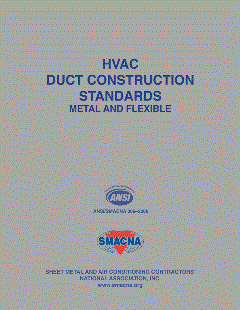
USES
Fibrous glass duct wrap insulation is designed for application to the exteriors of commercial and residential sheet metal heating, ventilating, and air conditioning ducts and plenums operating at temperatures between 40°F (4°C) and 250°F (121°C). Duct wrap insulation reduces heat loss or gain through duct walls, conserving energy and controlling moisture condensation. Fibrous glass duct wrap insulations are useful in situations where acoustical performance is not an issue.
DESCRIPTION
Fibrous glass duct wrap insulations are flexible, resilient, light-density blankets of glass fibers factory-laminated to vapor retarder facings. These products are easily cut and fitted to achieve a neat, thermally effective insulation blanket over the exteriors of rectangular, round, oval, or irregularly shaped duct surfaces. They are available in a range of R-values depending on product type, thickness, and density.FEATURES AND BENEFITS
Condensation controlWhen installed thickness recommendations are followed, fibrous glass duct wrap insulation installed over sealed sheet metal ducts reduces the likelihood of condensation occurring on the vapor retarder facing, and of moisture damage to ceilings and other interior finishes.

By reducing heat loss or gain through duct walls, conditioned air reaches occupied spaces at temperatures close to design conditions. Central air equipment may therefore be operated at reduced levels, saving energy.
Flexible, easily installed
Fibrous glass duct wrap insulation is easily cut to proper fit. For ease of application, a staple flap is provided by the manufacturers.
Code compliance
Fibrous glass duct wrap insulations meet the physical property requirements of ASTM C 1290 as well as meeting the fire safety requirements of NFPA 90A and 90B including limited combustibility. They also comply with all widely used model codes including ICC, BOCA, CABO, ICBO, and SBCCI.
ASSURED THERMAL PERFORMANCE
When installed in accordance with manufacturers' instructions, fibrous glass duct wraps will provide specified thermal performance as printed on the vapor retarder facing. This is achieved by determining the "stretch-out" cutting dimension required so that, once installed, the duct wrap is not compressed to less than 75 percent of nominal (out-of-package) thickness.
CONDENSATION CONTROL
Figure 1 shows the installed R-values of fibrous glass duct wrap required to prevent moisture condensation on the vapor retarder surface under varying conditions of ambient temperature and relative humidity. Curves are based on cold duct internal temperatures of 55°F (13°C) and no air movement on the external surface.Note: R-values as required by ASHRAE 90.1-1989 may not be sufficient for condensation control as may be seen in Figures 1 and 2.

INSTALLATION
Fibrous glass duct wrap insulations are installed with facings away from the duct surface. See Figure 2. A stapling flap, prepared at the time of installation, overlapping the insulation and facing at the other end of the piece of duct wrap, is stapled to form a longitudinal seam. Where a vapor retarder is required, the seam is sealed with pressure-sensitive tape. Adjoining duct wrap sections are similarly stapled and sealed using the facing flap on one edge of the duct wrap as produced at the factory. Seams and joints may also be sealed with mastic and glass fiber fabric.For complete installation details, consult the manufacturer or National Commercial and Industrial Insulation Standards, 1999, 5th Edition, Midwest Insulation Contractors Association (MICA).

Reprinted with permission from the North American Insulation Manufacturers Association's (NAIMA's) Insulation Facts #66: Fibrous Glass Duct Wrap. NAIMA is the association for North American manufacturers of fiberglass, rock wool, and slag wool insulation products. For more information, visit www.naima.org
Publication date: 04/03/2006




